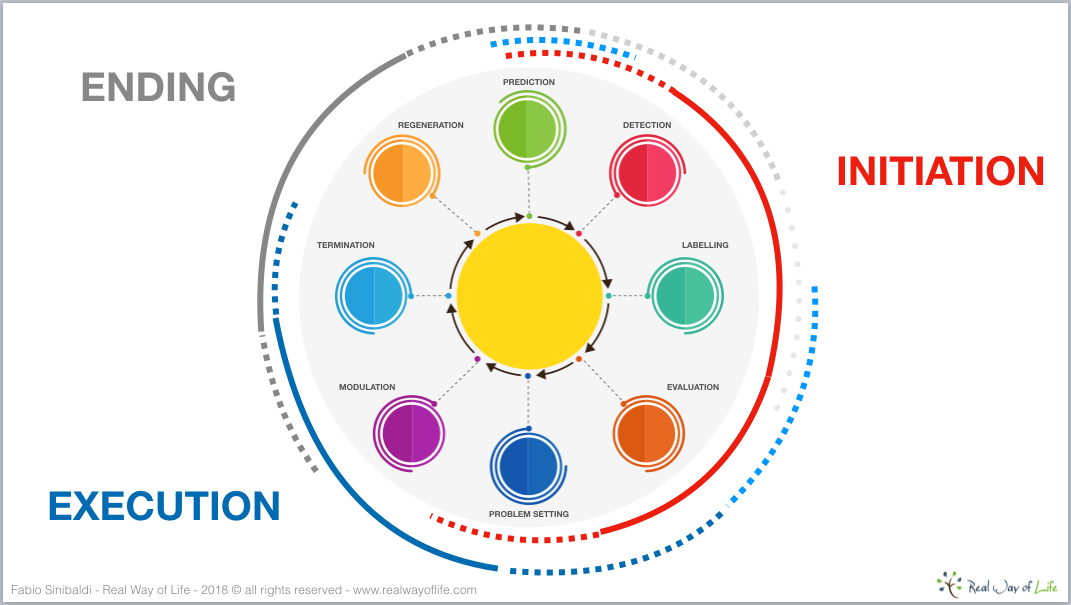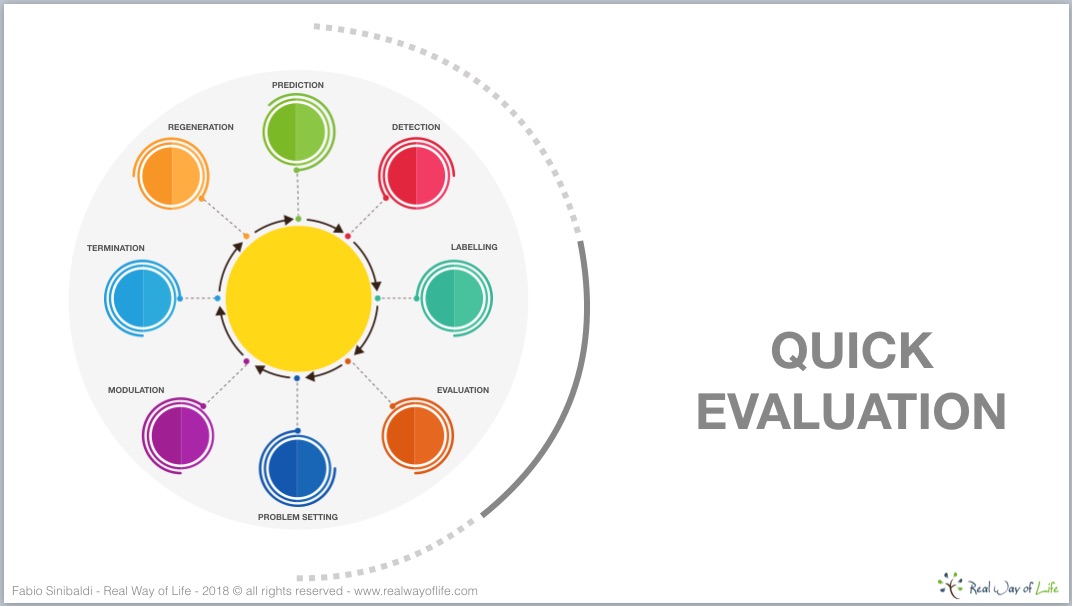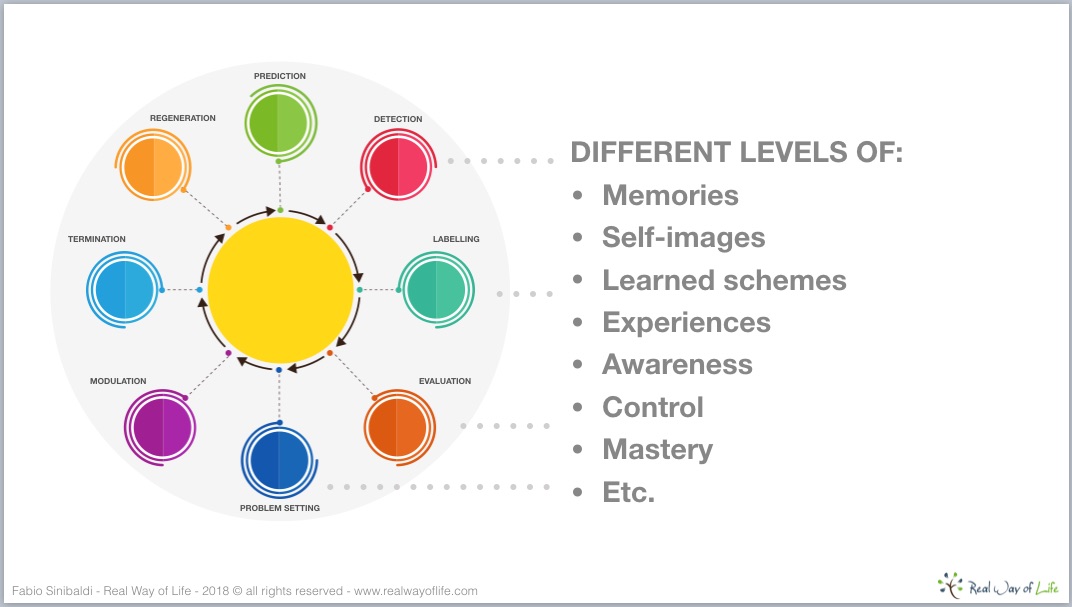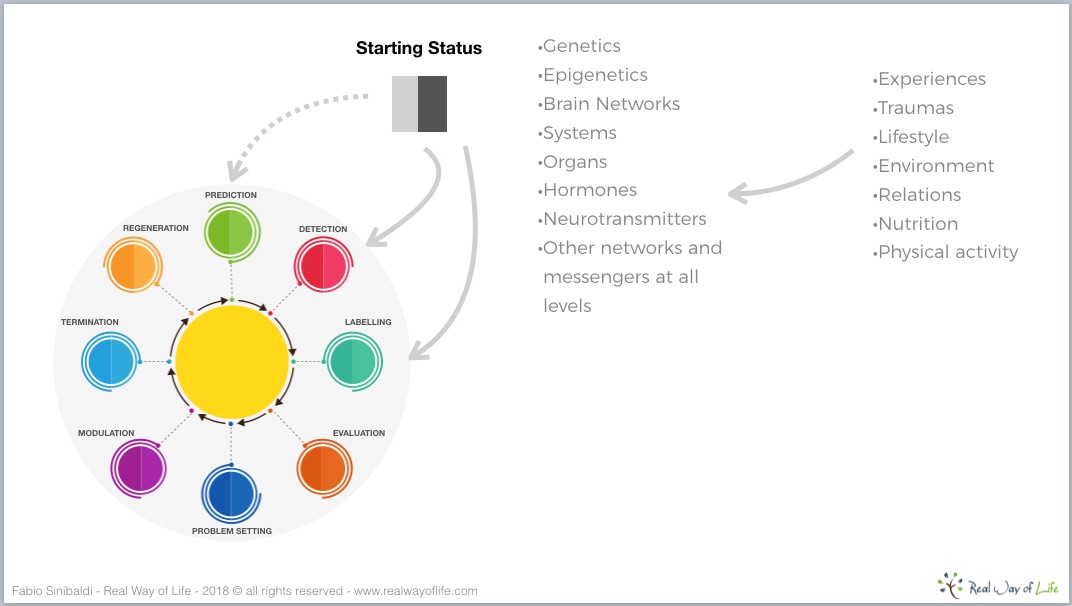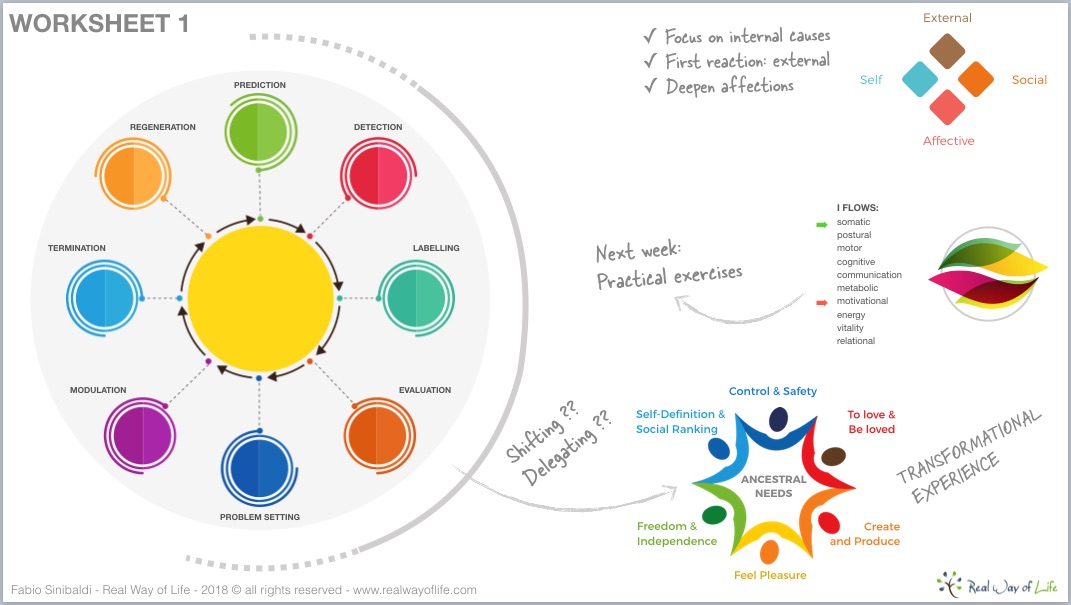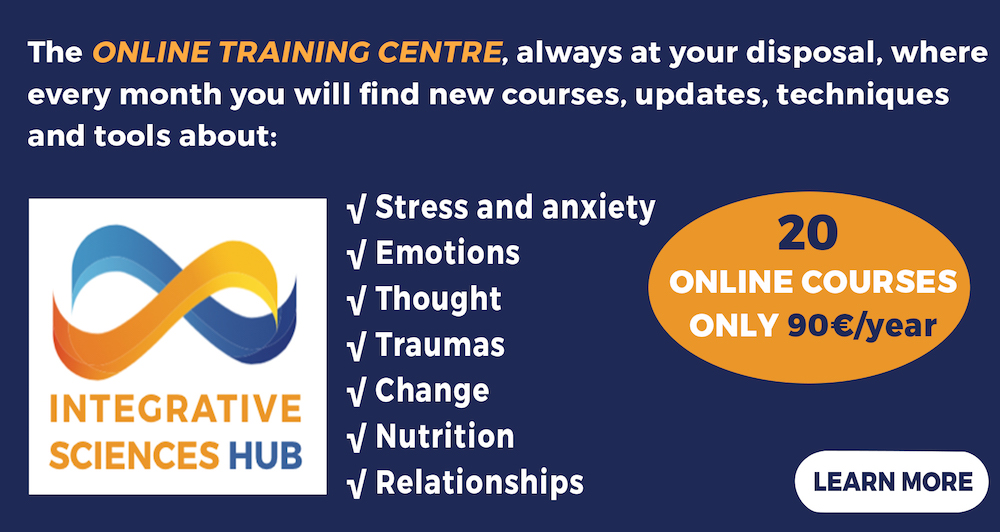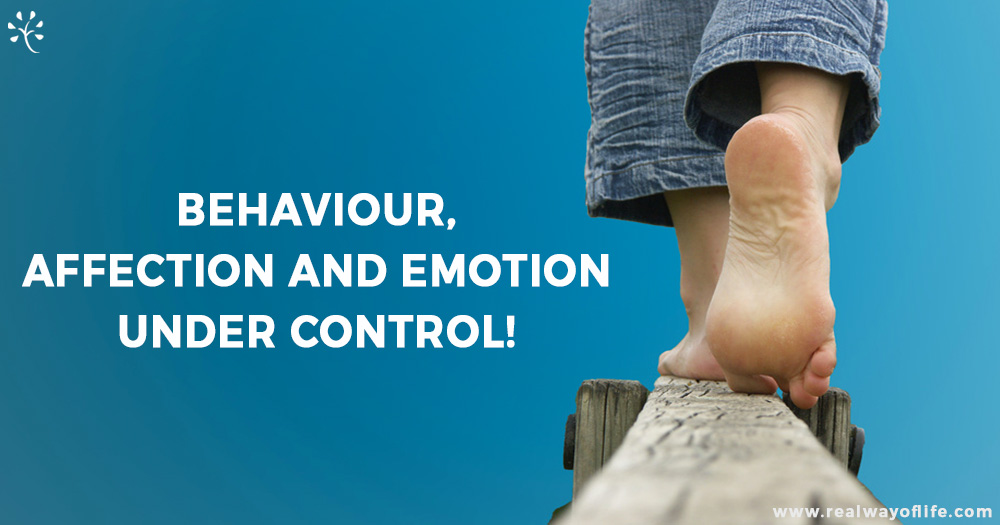
12 Jul Behaviour, affection and emotion under control: a practical, scientifically-based guide in modules
Article by Fabio Sinibaldi and Sara Achilli
Where does a specific behaviour start? How does it come into being?
This looks like a simple question, but it really is not!
Whether it’s the response to a potentially dangerous stimulus, what we say to someone to motivate them or to defend ourselves, or the result of a lengthy evaluation, it’s basically always an action that is taken to alter the existing state of things.
This often coincides with solving a problem and/or adding value. As we know, however, this process is not always so straightforward.
The routes and processes that follow on from each other are often very tortuous and not entirely conscious. We often act one way, when we’d actually planned to behave differently. In some instances the problem is solved, the possible action is terminated and yet thoughts persist.
This also takes place at a physical level: a state of physical activation remains over time even though it’s no longer useful or required.
It’s easy to identify this phenomenon regarding traumatic events, but it also takes place in many daily situations.
Just consider how many times after an argument is over, even conceding we were right, our body remains tense and active for hours later as though still prepared to face imminent danger? This doesn’t just happen with arguments, but as a result of worries, danger and conflict of any type.
3 MACRO-AREAS OF BEHAVIORAL, AFFECTIVE AND EMOTIONAL PATTERNS
Let’s start with setting out the macro-areas.
There is an initial phase (INITIATION) that is far more articulated and sophisticated than is usually expected.
There is also a final phase (ENDING) in which various systems and processes should terminate to return to their physiological state or, if possible, to an added- value state.
The third phase (EXECUTION) is related to the operational side of the resolution of a problem or to active change.
THE 8 PHASES OF THE PATTERNS: basic functions and integrative processes
The start of everything: from Detection to Evaluation, 4 phases that are often incorrectly separated
Even the simplest behaviour starts long before we see it in action.
During this “invisible” time many things take place that can influence whether the behaviour eventually takes place or not. In addition to this, these processes also affect the specific ways in which it will be shaped.
It all starts with the Detection of an initial stimulus that can be external or internal. Seeing a menacing tiger, a missed call on the telephone from someone that we have a bad relationship with, or even noticing a memo that reminds us of a deadline, or the re-emergence of a negative memory in our mind are all instances that activate the system.
First of all we carry out a rapid evaluation. Firstly, this initial evaluation is a process that takes place over more than one stage. We can sum them up in two main phases each composed of numerous steps and processes.
Anyone wishing to delve further into the reference framework can find these in the articles and videos on our blog. At this stage we’ll simply mention the two major authors on the subject: Joseph LeDoux and Luiz Pessoa.
The first of these two phases is extremely rapid and largely independent from conscious processes. It work a bit like triage in accident and emergency: a quick risk evaluation is provided factoring in but not limited to a range of different safety elements.
Social and developmental aspects are also taken into consideration. This is why we call this the Labelling phase.
This phase activates the very first physical responses and moves into the second phase of Evaluation, where the scenario of parameters taken into consideration expands significantly.
During the Labelling phase the Salience Network plays a key role. As the name suggests its role is that of a radar that perceives what is salient or ‘relevant’.
In case of positive reaction it activates adaptation processes, on the contrary, in case of a false alarm, it allows us to return to a state of calm.
The Salience Network is mainly based on physical data collected by the insula and on the threat criteria evaluated by the amygdala and other brain regions.
For this reason, in order to manage the very first emotional response and self-control it is important to work on body maps, on mastery, on physiology and on the management of space and other environmental and physical elements.
Taking a step back though, it’s important to remember that the Salience Network is already active during the Detection phase so these sensory elements can already be providing a filter- to our advantage or against- on the quantity and quality of what comes under our radar.
Let’s take a day-to-day example: if we’re in a negative frame of mind even a fly can set-off a negative reaction which can lead to so-called ‘irritation’ and eventually turn into stress, anger, impotence or aggressive responses. By contrast, if we’re in optimal conditions we don’t even notice that it’s flown into the room. This means the filter has been useful right from the very start and the labelling phase hasn’t taken place.
Regulating this stage provides a huge advantage: we can remain focused on what we are doing without even trying to control our thought processes, initiate self-control processes, or in general, we avoid wasted energy and over-stimulation of systems that, evolutionary speaking, exist to help us respond to rare and occasional danger.
Later we will see how this relates to the Termination phase, but let’s take things one step at a time.
Going back to our starting point: the process has been initiated and detection and labelling have ensued. We therefore have reached the proper Evaluation phase. In this phase the number of mechanisms involved increased, some of them are accessible (partially or entirely) to our consciousness. In any case, we will see that complete cognitive control starts with the following phase.
Somatic and procedural memories are involved during the Labelling phase and self-image is strictly physical and interiorised. During the Evaluation phase we enter the reign of narrated memories, of experiences that are shaped by self-image and are linked to vitality and primary socialisation.
In the next phase, Problem Setting, or the setting determining the most logical resolution of the issue, we see semantic memories enter the scene as well as conceptual schemes, cultural, contextual, ideal and value-based self-imagery.
This is just a quick run-down compared to the multi-faceted number of elements involved in this phase. Find further information and insight in the online Integrative Functional Patterns course. You can view the first course module free of charge (watch it now here).
In the free video you also find the following sections from which we anticipate a few key elements.
Extracts from the other sections
THE IMPORTANCE OF WHAT HAPPENS FIRST: PREVISION AND PRECONDITIONS
[…] Does everything really begin when we perceive a starting point?
No. Everything depends on two key elements.
the first relates to the conditions we’re in just before Detection activates: Pre-Conditions such as, for example, phenomena known as hyper- or hypo arousal, or in other words conditions of chronic activation (excessive or insufficient) of the sympathetic or parasympathetic system, of certain brain networks or other interconnected systems between mind-brain-immune system- metabolism and many others.
A person can find themselves in these conditions further to trauma, chronic stress, or other adverse conditions.
In these instances it’s critical to act on core physiology even before acting on the response cycle, using techniques that are especially targeted to act on these pre-conditions.
On the other hand, it can be interesting to act in a controlled manner on certain phases of activation, to achieve a positive effect on core physiology. For example, the phases of Modulation and Termination play a key role in managing these states of hyper or hypo activation through practice and experience.
There are also some other pre-conditions that can influence the outcome of events: epigenetic mutations, inflammation due to bad nutrition habits and/or drug abuse, sleep-wakefulness cycles, and various other behavioural aspects.
An integrated and integrative approach needs to consider all these elements to significantly improve later stage work.
With this approach, people feel assisted and accepted all-round, in every area of their daily life and with an outlook that strategically encompasses the past, the present and the future and that is aimed at achieving effectiveness rather than method for method’s sake.
The other element that plays a key role in the phase before reality takes shape is that of forecasting. Our brain is continuously making predictions; we do it to stay a step head and increase our safety, but there are also some interesting forecasting processes that relate to motivation, fulfilment and social interaction.
Our reaction often activates specific thoughts and emotions based more on forecasting than on actual perception. As shown by Lisa Barrett Feldman and other researchers, there is a neurological basis to this fact: the neural pathways that transmit predictions and pre-judgements (literally judgements made early) are faster and more powerful than those that carry internal and external sensory perception. This has important repercussions on our reactions but also on the distortions with which we evaluate reality. […]
MOVING ON TO ACTION: FROM REFLEXES TO FULL CONTROL
[…] the subsequent phases see evaluation and planning take shape and reach what represents – or at least should represent- the most structured type of human behaviour: the Modulation phase.
This is where complex actions can take place encompass all elements and envisioning longer-spanning temporal outcomes.
It’s usually the quality of this middle phase that brings about satisfaction and fulfilment.
It is often presumed that it’s the termination phase that brings about fulfilment and finally determines the quality of an action allowing us to state: “I did it!” In reality, the termination of a type of behaviour often is not fulfilling at all. This is something you are bound to have experienced as we all have done in more than one instance.
A useful system to understand Modulation and act on it directly is that of FLOWS, or in other words the ways our behaviour comes into actual being. There are somatic, relational, postural, motor, metabolic, motivational, energy and vitality Flow systems.
These flows can be expressed automatically, if they are the result of habits consolidated over time, or they can be innate and express basic functions relating to key needs, or they can even be managed and controlled by changing habits and using retro-feedback on acquired patterns (altered to your own advantage) or even by acting at a relational systems level […]
From rest to added value: adaptation, recovery and development
[…] Here the edges really blur between adaptation behaviour, self-realisation, motivation and psychosomatic conditions!
Just think of how, further to trauma or chronic stress, the state of activation continues to function, even though the problem has been overcome or resolved.
Termination phase disorders are easily found in daily life. One key example is that of people who can’t stop complaining […]
[…] If we think about it, there are termination processes at many levels: from the nervous system to the immune system, the motor system to personal interactions, from stress to pain. These are all interconnected and put the bidirectional relationships of alteration of our behaviour at risk.
These termination processes are mediated by various elements: the ability to understand interpersonal nurture relationships, those of trust or power; personal fulfilment, in the delicate balance between recovery, hedonism and motivation activities, Ancestral Needs, which can be satisfied immediately or vicariously and much more. […]
[…] The final phase to take into account is the so-called Regeneration phase which comes after termination. After an exertion it’s normal to seek rest; sleep is the most intuitive way to achieve this, but there are also many others.
The key aspect to highlight is that this phase is not just one of recovery. Instead, it actually has a significant development component: muscles don’t just rest, but become stronger, the nervous system is optimised, cells begin metabolic processes to improve energy deployment, but there’s still more. […]
Further analysis
This is the basic cycle of Integrative Functional Patterns in a nutshell.
The first module of the course is already available and contains numerous insights and practical tips.
In the next modules we’ll explore each phase in detail analysing the rules that govern them, how they interact with one another and we will look at which techniques and strategies to use to develop optimal functioning in relation to achieving our specific objectives.
The course is part of the HUB, our online platform enriched with new courses, insights and techniques on a monthly basis. The value of each individual course is very high, but you can access all of them free of charge if you register to the Association for Integrative Sciences at the yearly cost of just 90 euros!
> Find out more and register now!




